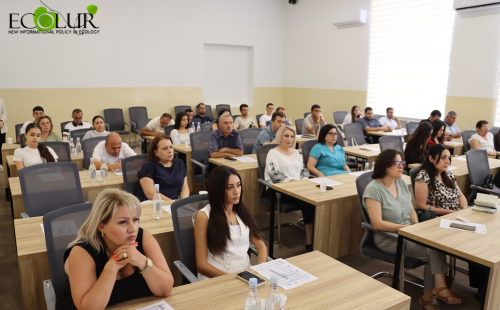

On July 29, 2025, a regional consultation on community needs for implementing climate change mitigation and adaptation policies was held at the Talin consolidated community municipality in Aragatsotn Region.
The meeting brought together Members of Parliament, representatives from the Ministry of Environment, Talin local self-government authorities, UNDP, NGOs, experts, and youth.

The consultation aimed to raise awareness on Armenia’s national climate commitments, particularly the 2021–2030 Nationally Determined Contributions (NDCs), collect input from Talin’s local authorities, civil society, and youth on climate challenges, needs, and opportunities, as well as facilitate dialogue with MPs and obtain responses from ministry representatives.
The consultation was organized within the framework of the UNDP FORSETI programme (“Fostering the Response, Efficiency, Sustainability, Transparency and Inclusiveness of the National Assembly of Armenia”), funded by the Governments of Sweden and Canada, in cooperation with the National Assembly of Armenia.

In addition to climate policy, the consultation addressed the prospects for waste management and renewable energy in Talin.
Wastes
Talin Mayor Tavros Sapeian noted that the community had applied for a standard-compliant landfill site two years ago, but the issue remains unresolved. “Our current landfill site, located near the road to Dashtadem fortress, is in an unbearable condition,” he noted.

Mnatsakan Nersisyan, Head of Talin municipality’s subsidy programmes, explained that waste sorting cannot yet be organized due to financial constraints: “Each waste type requires a separate collection vehicle. Even if we sort, where should we take it, what to do with it, to throw it in the same place? There is a gap of recycling companies in Armenia today.”
Mane Gasparyan, first-class specialist at Talin municipality’s Development Programmes Department, outlined the problems of Talin’s waste management and the ways to address them: “Currently, there are 3 landfills operating in the community territory. The technical conditions of these landfills do not meet modern environmental and health standards. There are no necessary infrastructures, control system, upper cover, or barriers. One of the biggest risks is that especially in summer spontaneous fires occur, which spread in the waste heaps and pollute the atmosphere. The released numerous dangerous chemical compounds disrupt the environment-the air, soil, water system, and people’s health. The existing landfills attract stray animals, which can become causes of spreading numerous diseases. Waste harbors microbes, numerous insects, pests, which become sources of infection. The unpleasant odor spreading from the landfills disrupts the quality of life of the adjacent settlements,” she said.

According to Mane Gasparyan, the first necessary step is the technical re-equipment of the operating landfills: “It is necessary to delimit the landfill in such a way that it has a clear entrance, control, a cover that protects from fire, rainwater, and wind. The area must be fenced so that it is possible to prevent the entry of animals, as well as control the order of waste placement. It is necessary to introduce a fire prevention and rapid response system. A monitoring system must be introduced, surveillance cameras installed, and also a clear response plan developed in case of emergency situations,” she noted. The next necessary step is public awareness: “It is necessary to explain to people that dumping prohibited materials in the landfill or causing a fire endangers the community residents,” Mane Gasparyan noted.
Solar Energy
UNDP Senior Climate Change Adviser Diana Harutyunyan noted that Talin, as a solar community, has great potential for the development of community solar plants. She gave examples of 2 similar projects: one in Artik under an EU programme, and the other in Alaverdi community installed by UNDP with Swedish co-financing. These plants provide communities with stable income. “There is an opportunity to build up to a 500 kW community solar plant according to the 15 MW quota approved by the government for communities. Today, new licenses are not being issued for commercial plants because without storage plants, increasing the share of renewable energy in the system causes frequency and stability problems. A 500-kW community solar plant can provide about 20 million AMD annual income. In Talin there are areas with rather high solar insolation indicators per square meter. The permanent income can become an opportunity for the community to implement new projects,” she noted.

Mnatsakan Nersisyan, in charge of the municipality’s subsidized programmes, noted that the community is considering the installation of solar plants on community buildings for the purpose of energy saving and heating. “On some community-owned buildings we must install solar plants, the heating system will be carried out with electricity. This is more beneficial for the community,” he said. Mnatsakan Nersisyan also noted that already in 2025, within subsidy programmes, they have submitted applications for the installation of plants with a total capacity of 340 kW.
Diana Harutyunyan proposed considering the possibility of creating a commercial community organization for the effective management of solar plants. She noted that it is necessary to consider the existing restrictions related to generation and consumption being in the same place.
August 20, 2025 at 15:15
